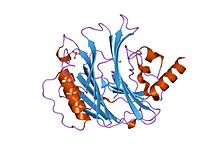Cytotoxic necrotising factor family (original) (raw)
From Wikipedia, the free encyclopedia
| CNF1 | |
|---|---|
 crystal structure of the inactive c866s mutant of the catalytic domain of e. coli cytotoxic necrotizing factor 1 crystal structure of the inactive c866s mutant of the catalytic domain of e. coli cytotoxic necrotizing factor 1 |
|
| Identifiers | |
| Symbol | CNF1 |
| Pfam | PF05785 |
| InterPro | IPR008430 |
| SCOP2 | 1hzg / SCOPe / SUPFAM |
| Available protein structures:Pfam structures / ECOD PDBRCSB PDB; PDBe; PDBjPDBsumstructure summary |
In molecular biology, the cytotoxic necrotising factor family of proteins includes bacterial cytotoxic necrotising factor proteins and the related dermonecrotic toxin (DNT) from Bordetella species. Cytotoxic necrotizing factor 1 (CNF1) is a toxin whose structure from Escherichia coli revealed a 4-layer alpha/beta/beta/alpha structure containing mixed beta-sheets.[1] CNF1 is expressed in strains of E. coli causing uropathogenic and neonatal meningitis. CNF1 alters host cell actin cytoskeleton and promotes bacterial invasion of the blood–brain barrier endothelial cells.[2] CNF1 belongs to a unique group of large cytotoxins that cause constitutive activation of Rho guanosine triphosphatases (GTPases), which are key regulators of the actin cytoskeleton .
Bordetella dermonecrotic toxin (DNT) stimulates the assembly of actin stress fibres and focal adhesions by deamidating or polyaminating Gln63 of the small GTPase Rho. DNT is an A-B toxin composed of an N-terminal receptor-binding (B) domain and a C-terminal enzymatically active (A) domain.[3]
- ^ Buetow L, Flatau G, Chiu K, Boquet P, Ghosh P (July 2001). "Structure of the Rho-activating domain of Escherichia coli cytotoxic necrotizing factor 1". Nat. Struct. Biol. 8 (7): 584–8. doi:10.1038/89610. PMID 11427886. S2CID 19515513.
- ^ Wang, Ming-Hsien; Kim, Kwang (2013). "Cytotoxic Necrotizing Factor 1 Contributes to Escherichia coli Meningitis". Toxins. 5 (11): 2270–2280. doi:10.3390/toxins5112270. ISSN 2072-6651. PMC 3847726. PMID 24284829.
- ^ Matsuzawa T, Kashimoto T, Katahira J, Horiguchi Y (July 2002). "Identification of a receptor-binding domain of Bordetella dermonecrotic toxin". Infect. Immun. 70 (7): 3427–32. doi:10.1128/iai.70.7.3427-3432.2002. PMC 128056. PMID 12065482.